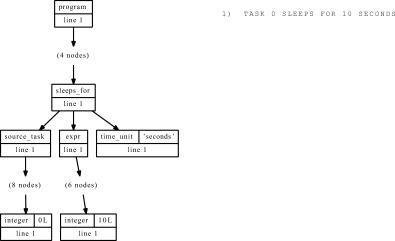
Next: The libsea_ast backend, Previous: The latex_vis backend, Up: Supplied backends [Contents][Index]
dot_ast backenddot is a format for describing graphs in terms of their edges
and vertices. The tools in the Graphviz suite typeset dot files in a variety of
output formats and using a variety of graph-layout algorithms.
coNCePTuaL’s
dot_ast backend outputs in dot format the abstract-syntax tree
corresponding to a given coNCePTuaL program. As an example,
dot_ast renders the one-line coNCePTuaL program
‘TASK 0 SLEEPS FOR 10 SECONDS’ as follows:

dot_ast is expected to be of particular use to
backend developers, who can use it to help prioritize the methods
that need to be implemented (i.e., implementing first the AST node types
needed by in a trivial program, then those needed by successively
more complex programs).
The
dot_ast backend accepts the following options from the
ncptl command line:
The programs in the Graphviz suite can output graphs in a
variety of formats such as PostScript, SVG, and PNG. By default, the
dot_ast backend outputs PostScript. The
--format option specifies an
alternate format to use. At the time of this writing, the Graphviz programs
support the following formats: canon,
cmap, dot, fig,
gd, gd2, gif,
hpgl, imap, ismap,
jpeg, jpg, mif,
mp, pcl, pic,
plain, plain-ext, png,
ps, ps2, svg,
svgz, vrml, vtx,
wbmp, and xdot. See the Graphviz
documentation for more information about these formats.
To facilitate associating nodes in the AST with
fragments of the coNCePTuaL program being graphed, the
dot_ast backend provides a --node-code option that
labels each node with the fragment of code to which it corresponds.
The argument to --node-code is a number of
characters at which to truncate the code fragment or
‘-1’ to inhibit truncation. The purpose of truncation
is to prevent excessively large nodes from disturbing the graph
layout. The
<program> node (see Complete programs),
for example, includes the complete program source code if not
truncated.
The
dot_ast backend’s --extra-dot option enables
the user to inject arbitrary dot code into the generated file. For example,
specifying --extra-dot="node [shape=Mrecord]"6 tells dot to use draw nodes as
rounded rectangles and specifying --extra-dot='edge
[color="green"]' colors all edges green. --extra-dot can be specified
repeatedly on the command line;
dot_ast concatenates all of the extra dot code with intervening
semicolons.
Normally, every node of the AST is drawn. The --compress option makes the resulting dot graph more readable by eliding chains of single-child nodes. For example, --compress reduces the previous graph of ‘TASK 0 SLEEPS FOR 10 SECONDS’ to the following:

By default, each AST node indicates the lines in the program’s source code to which it corresponds. The --no-lines option suppresses the outputting of source-code line numbers.
Every node in the AST has a
type. Some nodes additionally have an attribute.
dot_ast normally outputs attributes but --no-attrs prevents
dot_ast from doing so.
The complete source code corresponding to the AST is included in the generated dot graph unless --no-source is specified on the command line.
The DOT
environment variable names the Graphviz program that
dot_ast should run on the generated code. If DOT
is not set,
dot_ast uses whatever value was specified/discovered
at configuration time (see configure), with the default being
dot
. By default,
dot_ast produces dot code and runs this through the designated
Graphviz
program to produce a PostScript file (or whatever format is
named by the --format option). If ncptl
is run with either the --no-link or --no-compile options, it
produces a dot file
that should be run manually through dot or another
Graphviz
tool.
Next: The libsea_ast backend, Previous: The latex_vis backend, Up: Supplied backends [Contents][Index]